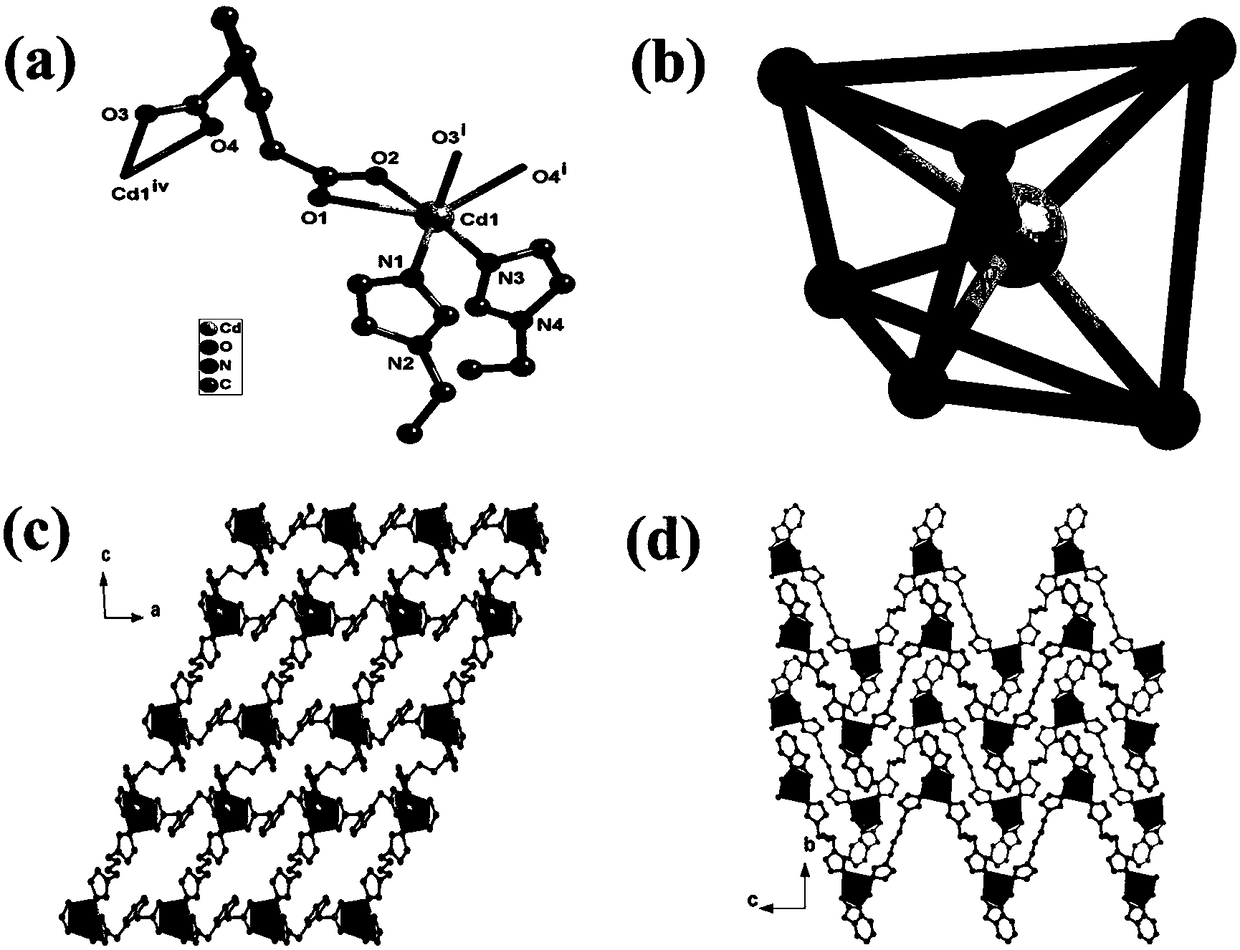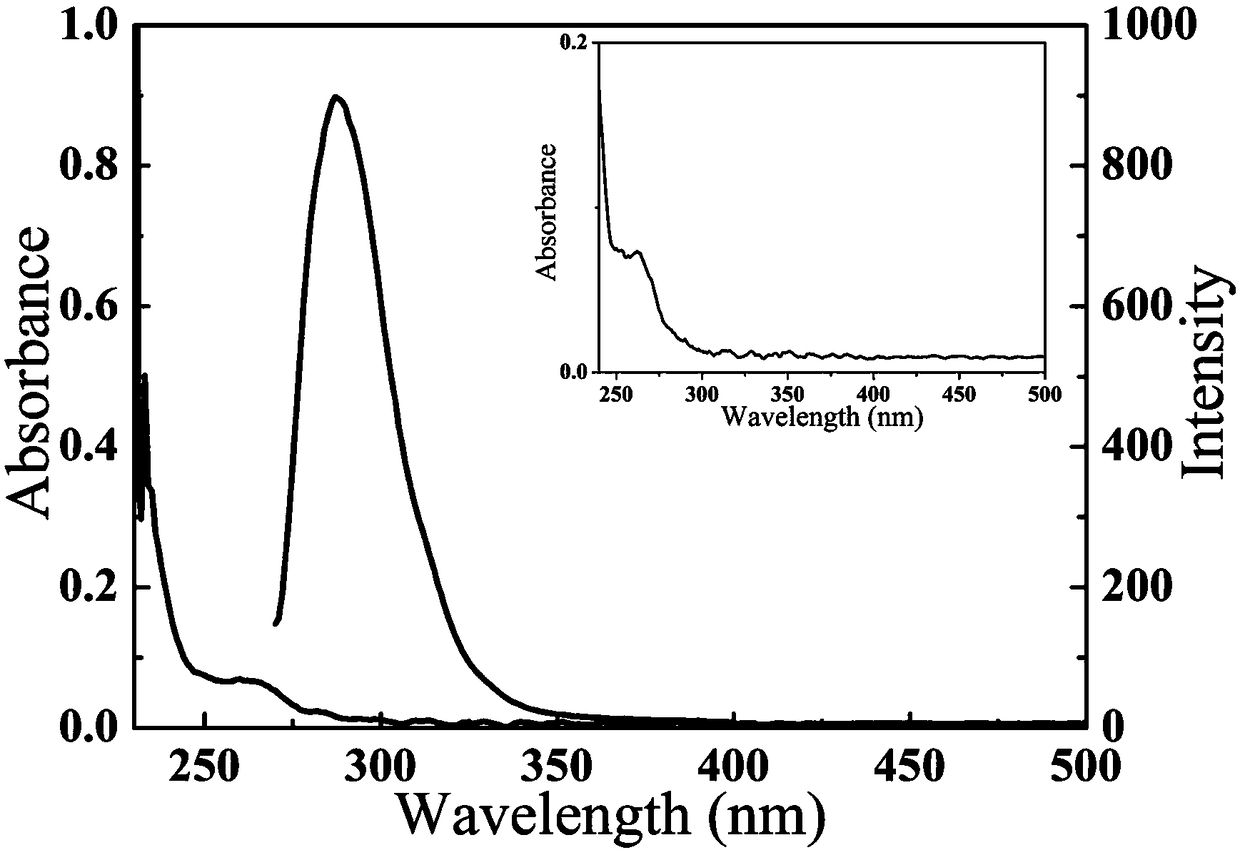MOF-Cd probe for detecting Fe3+ and antibiotic ceftriaxone sodium in water, preparation method and application thereof
A technology of ceftriaxone sodium and antibiotics, applied in the field of analytical chemistry, can solve problems such as expensive and time-consuming, and achieve the effect of low detection limit
- Summary
- Abstract
- Description
- Claims
- Application Information
AI Technical Summary
Problems solved by technology
Method used
Image
Examples
Embodiment 1
[0021] Embodiment 1 prepares the specific embodiment of MOF-Cd solution:
[0022] First synthesize the ligand bbi: weigh imidazole (0.05-0.1moL) and sodium hydroxide (0.05-0.1moL) and dissolve them in DMSO (10mL) for 2 hours at 60°C, then weigh 1,4-dichlorobutane (0.025 ~ 0.5moL) was added to the above solution several times, and after the reaction was continued for 2 ~ 3h, the solution was poured into a beaker containing 500mL of ice water and left to stand overnight to obtain a large amount of white needle-shaped product, which was obtained by suction filtration. Let dry and set aside.
[0023] Then weigh bbi (20-40mg), phthalic acid (20-40mg), Cd(NO 3 ) 2 (0.0494~0.1g) in DMA (10mL), stirred and dissolved, placed in a polytetrafluoroethylene liner, and reacted at 80°C for 40~48h to obtain a colorless transparent single crystal. figure 1 is the obtained MOF-Cd structure.
[0024] Add 20 mg of single crystal to a centrifuge tube of 5 mL DMSO for ultrasonic dispersion, and...
Embodiment 2
[0026] Example 2: MOF-Cd as a fluorescent probe for Fe 3+ detection
[0027] Add 150 μL of metal ion solution to the MOF-Cd solution and add Fe respectively 3+ , Eu 3+ , La 3+ , Y 3+ , Ba 2+ , Ni 2 + ,Co 2+ , Ag + , Zn 2+ ,Sr 2+ , Cd 2+ , K + , Mn 2+ , Na + , Li + , Mg 2+ , Ca 2+ . image 3 Middle Fe 3+ The fluorescence of MOF-Cd solution decreased obviously.
[0028] In MOF-Cd solution, when Fe 3+ When the amount of MOF-Cd increased from 0 μL to 40 μL, the fluorescence intensity of MOF-Cd decreased monotonously and sharply, Figure 4 with Fe 3+ With the increase of concentration, the fluorescence intensity of MOF-Cd solution was gradually quenched. This indicates that MOF-Cd can be used as a fluorescent probe for Fe 3+highly sensitive. The fluorescence quenching efficiency can be quantitatively explained by the Stern-Volmer (SV) equation, and the detection limit can also be calculated: where I 0 is the fluorescence intensity before the analyte, I is ...
Embodiment 3
[0031] Example 3: MOF-Cd as a fluorescent probe for the detection of ceftriaxone sodium
[0032] Add 15 μL of antibiotic solution to the MOF-Cd solution, add SXT (sulfamethoxazole), MTR (metronidazole tablets), CFM (cefixime), CED (cefradine), CEC (cefaclox), CSU respectively (ceftiamidine), FOX (cefoxitin sodium), ATM (aztreonam), GEN (gentamycin sulfate), AZM (azithromycin), AMX (amoxicillin), ERY (erythromycin ethyl succinate) , AMK (acamicin), CRO (ceftriaxone sodium), PEN (penicillin sodium), AZL (azithromycin lactobionate), LIN (lincomycin hydrochloride). Figure 7 The fluorescence of MOF-Cd significantly decreased by ceftriaxone sodium.
[0033] In MOF-Cd solution, when the amount of ceftriaxone sodium increased from 0 μL to 7 μL, the fluorescence intensity of MOF-Cd decreased monotonously and sharply, Figure 8 with Fe 3+ With the increase of concentration, the fluorescence intensity of MOF-Cd solution was gradually quenched. By calculation, the detection limit is ...
PUM
 Login to View More
Login to View More Abstract
Description
Claims
Application Information
 Login to View More
Login to View More - R&D
- Intellectual Property
- Life Sciences
- Materials
- Tech Scout
- Unparalleled Data Quality
- Higher Quality Content
- 60% Fewer Hallucinations
Browse by: Latest US Patents, China's latest patents, Technical Efficacy Thesaurus, Application Domain, Technology Topic, Popular Technical Reports.
© 2025 PatSnap. All rights reserved.Legal|Privacy policy|Modern Slavery Act Transparency Statement|Sitemap|About US| Contact US: help@patsnap.com



